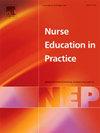The balancing act of competence assessment in placement: postgraduate critical care nursing students’ and preceptors’ experiences. A qualitative study
IF 3.3
3区 医学
Q1 NURSING
引用次数: 0
Abstract
Aim
To explore how postgraduate critical care nursing students and preceptors experience the assessment of students’ competence in placement.
Background
Assessing postgraduate critical care nursing students` competence in placement is a complex and essential part of precepting students.
Design
Explorative qualitative study.
Methods
Four focus group interviews and four individual interviews were employed with 15 postgraduate critical care nursing students and 12 preceptors in Norway. Data were analysed by inductive content analysis.
Results
The critical care nursing students felt vulnerable due to constantly being assessed despite their previous work experience as nurses. They experienced the need to appear humble and self-critical when assessing themselves. The “chemistry” between students and preceptors could influence the assessment. The preceptors experienced that it was a great responsibility to assess whether the students had sufficient competence and struggled to balance their roles as critical care nurses and preceptors. Clear assessment criteria including both technical- and non-technical skills, regular assessment meetings and support from teachers were regarded valuable.
Conclusions
Placements with competence assessment contribute to both students´ and preceptors’ professional development. Clear frameworks and constructive feedback from preceptors are crucial for students’ learning process. The preceptors should build on the students’ previous competence as nurses to create a safe learning environment. How students are met in the community of practice can be of importance for their learning outcomes and desire to stay in the profession. Given the need for highly qualified critical care nurses, prioritizing quality education for students in placements is essential.
安置中能力评估的平衡行为:研究生重症护理学生与导师的经验。定性研究
目的探讨危重病护理专业研究生及导师在实习中对学生能力评估的体会。背景评估危重护理研究生实习能力是培养学生的一个复杂而重要的环节。设计探索性质的研究。方法采用4次焦点小组访谈和4次个人访谈,对挪威15名危重病护理研究生和12名辅导员进行调查。资料采用归纳内容分析法进行分析。结果危重病护理专业学生虽有护理工作经验,但因不断接受评估而感到脆弱。他们在评估自己时需要表现得谦虚和自我批评。学生和老师之间的“化学反应”会影响评估。导师认为评估学生是否有足够的能力是一项重大的责任,并努力平衡他们作为重症护理护士和导师的角色。明确的评估标准,包括技术和非技术技能,定期评估会议和教师的支持被认为是有价值的。结论能力评估实习对学生 和导师的专业发展都有促进作用。清晰的框架和导师的建设性反馈对学生的学习过程至关重要。辅导员应以学生以前的护理能力为基础,创造一个安全的学习环境。学生如何在实践社区中得到满足,对他们的学习成果和留在这个行业的愿望至关重要。鉴于对高素质重症护理护士的需求,优先考虑对实习学生的优质教育至关重要。
本文章由计算机程序翻译,如有差异,请以英文原文为准。
求助全文
约1分钟内获得全文
求助全文
来源期刊

Nurse Education in Practice
NURSING-
CiteScore
5.40
自引率
9.40%
发文量
180
审稿时长
51 days
期刊介绍:
Nurse Education in Practice enables lecturers and practitioners to both share and disseminate evidence that demonstrates the actual practice of education as it is experienced in the realities of their respective work environments. It is supportive of new authors and will be at the forefront in publishing individual and collaborative papers that demonstrate the link between education and practice.
 求助内容:
求助内容: 应助结果提醒方式:
应助结果提醒方式:


